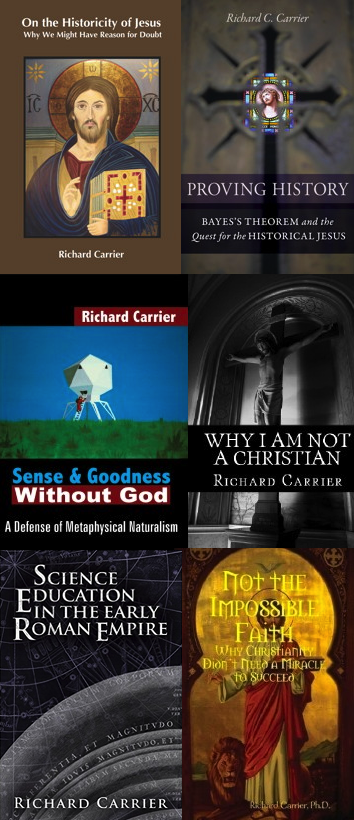To date I have written eight books. All are available in print, electronic, and audio editions, read by me. Several of them I even use as course texts in online classes you can take. I’m often asked “Which one should I start with?” The answer depends on your needs, interests, and style. Here’s a guide…
 Why I Am Not a Christian: A good, short read (less than a hundred pages). Summarizes four top reasons Christianity is false (God is inert, God is silent, the evidence is wrong, the universe is wrong), worded to anticipate and overcome all the usual rationalizations Christians have concocted to date. It’s great for handing out to door-to-door evangelists, or religious relatives or colleagues, or just boning up on great ways to make these points yourself. And if you are a believer questioning your faith. 83 pages. Philosophy Press.
Why I Am Not a Christian: A good, short read (less than a hundred pages). Summarizes four top reasons Christianity is false (God is inert, God is silent, the evidence is wrong, the universe is wrong), worded to anticipate and overcome all the usual rationalizations Christians have concocted to date. It’s great for handing out to door-to-door evangelists, or religious relatives or colleagues, or just boning up on great ways to make these points yourself. And if you are a believer questioning your faith. 83 pages. Philosophy Press.
 Sense and Goodness without God: A complete philosophy of life. Summarized and defended, every element needed to compare it to so-called Christian worldviews. Mostly about positive beliefs, what atheists should believe in, rather than what they don’t (though there is a section on that too). How we know things, what we know about all the things, and what most likely fills the remaining gaps and why. Also how best to think about politics, aesthetics, metaphysics, and ethics. You can use this as a model to build your own worldview from. It’s also a good introduction to what philosophy is, and is really for. I employ this as the main course text in my online class Developing & Defending Naturalism as a Worldview. 424 pages. AuthorHouse.
Sense and Goodness without God: A complete philosophy of life. Summarized and defended, every element needed to compare it to so-called Christian worldviews. Mostly about positive beliefs, what atheists should believe in, rather than what they don’t (though there is a section on that too). How we know things, what we know about all the things, and what most likely fills the remaining gaps and why. Also how best to think about politics, aesthetics, metaphysics, and ethics. You can use this as a model to build your own worldview from. It’s also a good introduction to what philosophy is, and is really for. I employ this as the main course text in my online class Developing & Defending Naturalism as a Worldview. 424 pages. AuthorHouse.
 Not the Impossible Faith: This one is fun. An educational and entertaining take-down of a Christian apologist’s silly argument that Christianity did everything wrong to succeed, therefore Jesus must have actually risen from the dead! That book was named The Impossible Faith. So now whenever anyone searches for his book on Amazon, mine comes up right beneath it! You’ll learn lots of stuff about ancient culture and literature, early Christianity and its Jewish and pagan contexts, and more. Refutes claims like “women witnesses were forbidden in court” and “no one would have worshiped an executed criminal.” Eighteen arguments. Eighteen chapters. 453 pages. Lulu.
Not the Impossible Faith: This one is fun. An educational and entertaining take-down of a Christian apologist’s silly argument that Christianity did everything wrong to succeed, therefore Jesus must have actually risen from the dead! That book was named The Impossible Faith. So now whenever anyone searches for his book on Amazon, mine comes up right beneath it! You’ll learn lots of stuff about ancient culture and literature, early Christianity and its Jewish and pagan contexts, and more. Refutes claims like “women witnesses were forbidden in court” and “no one would have worshiped an executed criminal.” Eighteen arguments. Eighteen chapters. 453 pages. Lulu.
 On the Historicity of Jesus: The magnum opus. Examines all the evidence for and against Jesus having existed as an ordinary guy, whose story was only exaggerated over time—rather than starting out a phantom of apostolic visions and dreams, and placed in earth history a lifetime later. The first peer reviewed treatment of the question in a hundred years; and as thorough as it gets. But also a treasure trove of facts about the origins of Christianity and its political, cultural, and religious context that you’ll find useful and fascinating regardless of the book’s conclusion. Why were Christians hallucinating all the time? What was their creed really about? Why didn’t they record anything? Exposes the mythical nature of the Gospels and Acts, the weirdness of the Epistles, and why none of it is corroborated outside the Bible. Extensive footnotes and indexes. I employ this as the main course text in my online class Questioning or Defending the Historicity of Jesus. 696 pages. Sheffield-Phoenix.
On the Historicity of Jesus: The magnum opus. Examines all the evidence for and against Jesus having existed as an ordinary guy, whose story was only exaggerated over time—rather than starting out a phantom of apostolic visions and dreams, and placed in earth history a lifetime later. The first peer reviewed treatment of the question in a hundred years; and as thorough as it gets. But also a treasure trove of facts about the origins of Christianity and its political, cultural, and religious context that you’ll find useful and fascinating regardless of the book’s conclusion. Why were Christians hallucinating all the time? What was their creed really about? Why didn’t they record anything? Exposes the mythical nature of the Gospels and Acts, the weirdness of the Epistles, and why none of it is corroborated outside the Bible. Extensive footnotes and indexes. I employ this as the main course text in my online class Questioning or Defending the Historicity of Jesus. 696 pages. Sheffield-Phoenix.
 Jesus from Outer Space: My brief popular market summary of On the Historicity of Jesus. This cuts to the chase, reducing the argument to its bare essentials, illustrating with examples, and addressing common misunderstandings of the theory—such as explaining why it is indeed “outer space” that even historicist Christians believed Jesus came from, and why this matters to understanding the debate. This is the book to get if you want the short read, and easy introduction, without footnotes and elaborate background information. It’s also the book to recommend or buy for someone you think might be intimidated by or not have time to read the dense 700-page academic monograph (which they can always turn to when they want deeper questions answered). 230 pages. Pitchstone.
Jesus from Outer Space: My brief popular market summary of On the Historicity of Jesus. This cuts to the chase, reducing the argument to its bare essentials, illustrating with examples, and addressing common misunderstandings of the theory—such as explaining why it is indeed “outer space” that even historicist Christians believed Jesus came from, and why this matters to understanding the debate. This is the book to get if you want the short read, and easy introduction, without footnotes and elaborate background information. It’s also the book to recommend or buy for someone you think might be intimidated by or not have time to read the dense 700-page academic monograph (which they can always turn to when they want deeper questions answered). 230 pages. Pitchstone.
 Hitler Homer Bible Christ: All my peer reviewed journal articles and magazine articles—on the subject of history—for one low price. Including my Skeptical Inquirer article on the FOX News pyramid aliens nonsense; all my published studies on mentions of Jesus in Thallus, Josephus, and Tacitus; and my exposure in German Studies Review of fraudulent Hitler quotes making him sound like an atheist—showing why the only English edition of the Table Talk is not a reliable source. Plus several other goodies, such as a thorough proof that Matthew and Luke place the birth of Jesus ten years apart (refuting every attempt Christians have made to deny that), and a thorough proof that the long ending of Mark is a forgery (also revealing several other forged endings some Bibles have that you probably didn’t know about!). And more. I employ this as the main course text in my online class New Testament Studies for Everyone. 395 pages. Philosophy Press.
Hitler Homer Bible Christ: All my peer reviewed journal articles and magazine articles—on the subject of history—for one low price. Including my Skeptical Inquirer article on the FOX News pyramid aliens nonsense; all my published studies on mentions of Jesus in Thallus, Josephus, and Tacitus; and my exposure in German Studies Review of fraudulent Hitler quotes making him sound like an atheist—showing why the only English edition of the Table Talk is not a reliable source. Plus several other goodies, such as a thorough proof that Matthew and Luke place the birth of Jesus ten years apart (refuting every attempt Christians have made to deny that), and a thorough proof that the long ending of Mark is a forgery (also revealing several other forged endings some Bibles have that you probably didn’t know about!). And more. I employ this as the main course text in my online class New Testament Studies for Everyone. 395 pages. Philosophy Press.
 Proving History: My peer reviewed treatise on the logic of historical method, including basic principles and axioms, and why all valid methods reduce to Bayes’ Theorem. Explains what Bayes’ Theorem is, and why it models all valid reasoning about history (like Inference to the Best Explanation), and addresses all significant objections to this conclusion. Then applies this finding to the “Method of Criteria” invented in Jesus studies, showing none of it is logically sound or valid (though reaching no conclusion as to what this means for Jesus; that’s in Historicity). Includes a full survey of all other peer reviewed studies devoted to examining those Criteria, showing every single one reached the same conclusion: they don’t work. I employ this as the main course text in my online class Historical Methods for Everyone. 340 pages. Prometheus (Rowman & Littlefield).
Proving History: My peer reviewed treatise on the logic of historical method, including basic principles and axioms, and why all valid methods reduce to Bayes’ Theorem. Explains what Bayes’ Theorem is, and why it models all valid reasoning about history (like Inference to the Best Explanation), and addresses all significant objections to this conclusion. Then applies this finding to the “Method of Criteria” invented in Jesus studies, showing none of it is logically sound or valid (though reaching no conclusion as to what this means for Jesus; that’s in Historicity). Includes a full survey of all other peer reviewed studies devoted to examining those Criteria, showing every single one reached the same conclusion: they don’t work. I employ this as the main course text in my online class Historical Methods for Everyone. 340 pages. Prometheus (Rowman & Littlefield).
 The Scientist in the Early Roman Empire: My Columbia University dissertation, expanded and summarized for a lay audience (but with ample footnoting for scholars). Who were scientists in the Roman Empire? What did they do? What did people think of them? Were they valued? Hated? Ignored? Did they believe in scientific progress? Did they make scientific progress? What was ancient science like? What did they know? How far did they get? And how did pagan values differ from Christian? A whole chapter on that last question finds that Christians in the first three centuries were very hostile to the basic scientific values of curiosity, empiricism, and progress. And that this explains the lack of scientific progress for the entirety of the Middle Ages, even in fact most technological progress (refuting recent claims to the contrary). I employ this as the main course text in my online class on Ancient Science & Technology. 645 pages. Pitchstone.
The Scientist in the Early Roman Empire: My Columbia University dissertation, expanded and summarized for a lay audience (but with ample footnoting for scholars). Who were scientists in the Roman Empire? What did they do? What did people think of them? Were they valued? Hated? Ignored? Did they believe in scientific progress? Did they make scientific progress? What was ancient science like? What did they know? How far did they get? And how did pagan values differ from Christian? A whole chapter on that last question finds that Christians in the first three centuries were very hostile to the basic scientific values of curiosity, empiricism, and progress. And that this explains the lack of scientific progress for the entirety of the Middle Ages, even in fact most technological progress (refuting recent claims to the contrary). I employ this as the main course text in my online class on Ancient Science & Technology. 645 pages. Pitchstone.
 Science Education in the Early Roman Empire: A brief, affordable companion volume to the above. It surveys the entire education system of the Roman period, including even pop culture, and then focuses on how much science was included in it and of what quality. Also covers questions like how philosophers and scientists were educated, who got to have an education (women? slaves?), what it cost and covered, and how Christians and pagans differed on its value and importance. Also shows the Romans actually had numerous universities (contrary to common assumption) and educational subsidies, academic societies, public libraries, and charitable foundations for schools. We also read excerpts from this in my course on Ancient Science & Technology. 207 pages. Pitchstone.
Science Education in the Early Roman Empire: A brief, affordable companion volume to the above. It surveys the entire education system of the Roman period, including even pop culture, and then focuses on how much science was included in it and of what quality. Also covers questions like how philosophers and scientists were educated, who got to have an education (women? slaves?), what it cost and covered, and how Christians and pagans differed on its value and importance. Also shows the Romans actually had numerous universities (contrary to common assumption) and educational subsidies, academic societies, public libraries, and charitable foundations for schools. We also read excerpts from this in my course on Ancient Science & Technology. 207 pages. Pitchstone.
Now that you have the gist, you can recommend them to others, or find links to purchase any of these books, in any format, on my Books page. As an Amazon associate I also receive a commission on any purchases you make there through links on my website.
I also helped develop an app for the historicity of Jesus called CHRESTUS. It contains a configurable Bayesian calculator, and a growing argument-tree of all arguments for and against historicity that I’ll be expanding considerably before year’s end.
Enjoy!







Out of curiosity and for the sake of completeness, I was wondering which of Loftus’ and others’ anthologies you are in?
The first three. All the ones I sell on my page here. Each has two chapters by me. And much else that’s pretty great, IMO.
I have all of these books. Enjoyed every single one. When I was done reading them, I passed them out to my kids and in-laws too. They’ve borrowed them again and again. Great reference works.
These books are important works for anyone who is looking for more detail on the entire Christian mythology.
They’ve replaced the false foundation I had as a Christian evangelist. History and facts are the real substitute (the right answer) for superstition and ‘belief’. The Christian myth can only be better understood by knowing what actually happened.
I have some evidence I would like you to review that is evidence of Jesus Christ through the Book of Mormon. There is dna, cultural, and linguistic evidence. If you are not familiar with the Book of Mormon members of the tribe of Manasseh and other old world parties travel from the Middle East to North America. They thrive Christ visits them and they are them wiped out. Could you review the evidence?
Thanks
David
Middles East DNA in Native Americans
http://bookofmormonevidence.blogspot.com/2016/09/best-book-of-mormon-dna-evidence-x2a.html
Native American Hebrew and Old World Language Ties
http://bookofmormonevidence.blogspot.com/2016/09/native-american-hebrew-language.html
Native American Hebrew like temples
http://bookofmormonevidence.blogspot.com/2016/09/native-american-hebrew-like-temples.html
Native American Jewish Hamsa Symbol
http://bookofmormonevidence.blogspot.com/2016/09/native-american-jewish-hamsa-symbol.html
Reformed Egyptian Four Surviving Characters
http://bookofmormonevidence.blogspot.com/2016/09/native-american-egyptian-hieroglyph.html
Nephite (Hopewell Mik Maq) Old World Burial Rites and Rituals
http://bookofmormonevidence.blogspot.com/2016/11/nephite-hopewell-mik-maq-old-world.html
DNA Evidence of A European/Middle East race of Indian
http://bookofmormonevidence.blogspot.com/2016/09/dna-evidence-of-white-race-of-indian_12.html
The extermination of a European/Middle East Indian Civilization
http://bookofmormonevidence.blogspot.com/2016/09/the-extermination-of-white-race-of.html
Children of Israel and Native American Fiery Flying Serpents
bookofmormonevidence.blogspot.com/2016/11/children-of-israel-and-native-american.html
Mik Maq Nephites and Christ visit
http://bookofmormonevidence.blogspot.com/2016/10/mik-maq-nephites-and-christ-visit.html
That’s all pseudoscientific crankery. Start with the corrective of reading The Mormons by Fitzgerald, and following up using his bibliography. You can also research these claims yourself and find you are being lied to or snowed with fallacious rigmarole. For example, just read the Wikipedia article “Genetics and the Book of Mormon,” for example. You should direct further questions to actual experts who critique Mormonism. Mormonism isn’t my field and I haven’t written on it.
Hello,
Do you have any reliable references for a list of gods who share traits (born of a virgin, born on December 25th, crucified etc…)with Jesus but were worshiped before the supposed time of Jesus?
I went to Wikipedia which has a fantastic list and dates and was pleasantly surprised they mentioned you as a skeptic of veracity on some of the facts.
https://en.m.wikipedia.org/wiki/The_World%27s_Sixteen_Crucified_Saviors
Many internet and amateur claims of parallels are indeed false or misrepresented. Or conflate different gods. I never rely on Wikipedia for this though, because it is constantly vandalized by cranks and ideologues on both sides of the issue. It is never a reliable source on this. But worse is the Graves book from the 19th century you are linking to. I wrote a whole article for the Secular Web on the unreliability of that.
That’s why I produced peer reviewed work to replace it with (see Element 31 in Ch. 5 of OHJ, for example) and a couple of articles here:
Virgin Birth: It’s Pagan, Guys. Get Over It.
Dying-and-Rising Gods: It’s Pagan, Guys. Get Over It.
I thought so. Thanks!
Hi, Dr. Carrier. I was just wondering. What book(s) are you thinking of writing next? (Jesus from Outer Space looks interesting and hopefully I’ll get around to it, just a bit busy).
I think you’ve mentioned in the past that you plan on separating the main sections of Sense and Goodness into their own books, ie. one for epistemology, one for ethics, etc. If so, I think that’s a great idea cuz I think your philosophical work is fairly underrated.
Regardless, I’m sure whatever it is will be good.
That’s still a possibility. I don’t have anything planned yet. I have a long list of possibles. An anthology of my peer reviewed philosophy papers among them (to go along with my one on history papers, Hitler Homer Bible Christ).
An ex-Muslim turned Agnostic a year ago here.
I have been reading a lot of your articles here (and articles from Bart Ehrman as well) lately as I think if any religion ever could turn to be right, it would be either Christianity or Islam.
After 11 years of doubt, I know Islam is not. I am now interested in learning about Christianity. Just bought your “Why I am not a Christian” book.
Do you have any other suggestions (books) on refuting Christianity written by other writers?
Hello. Welcome to the community!
Answering your question would depend on what precisely you need.
Because different books “refuting Christianity” focus on different things. There is no one-stop shop for them all. For example, there are many critiques of its moral degeneration written even by Christians. There are some great books on resurrection apologetics. And yet different books on its cosmological arguments. Others on Thomist Christianity (the fad in Catholicism today but almost irrelevant to Protestantism). Others on Biblical studies generally. And yet others focusing on different aspects of that (contradictions, historicity, New Testament vs. Old, moral failings, philosophical shortfalls). And so on.
After Why I Am Not a Christian, which was written to fill the one-stop shop gap as briefly as possible, I’d recommend the anthology series by John Loftus (Christian Delusion, End of Christianity, Christianity Is Not Great, Christianity in the Light of Science, and now under a new imprint, God and Horrendous Suffering).
Those have the virtue that they cover a lot of bases from a lot of different experts, and in turn cite or reference good critiques on many of the subjects covered.
Apart from that, IMO, rather than books, read my extended critique series on specific defenses of Christianity (top of that list, Timothy Keller on the dishonest conservative side, and on the honest liberal side, Justin Brierley), because in those I sometimes cite other experts to consult on specific points of critique.
Although the top books, right now, on general refutations of theism (not just Christianity) include Lataster’s Case Against Theism, Fodor’s Unreasonable Faith, and Murray’s Atheist’s Primer.
Thanks a lot for your detailed and helpful response!
In retrospect, I think the question was indeed too broad. I am, however, glad that I asked it that broadly because this wide answer is in fact what I currently need.
By the way, very nice article on Islamic counter-apologetics although I think the work of Islamic apologetics in Arabic is much more advanced and sophisticated than in English. The Arabic Islamic apologetics I have in mind read widely in English but 99% of their work is in Arabic.
You would be surprised how much they are aware of Christian apologetics general work on theism and on the New Atheism writings.
That also sounds new. If Arabic work is actually engaging with 21st century critiques (e.g. the New Atheists), then it has finally given up on its outdated, naive, and isolationist mode and is trying now to sound more like Western Christian apologetics.
If anything good in that echelon comes into English translation, please let me know. I’d be interested in addressing whatever would count now as “the best” Islamic apologetics.
They unfortunately write almost exclusively in Arabic.
The only English book that this group of Islamic apologetics ever produced is “The Only Way Out”
https://amzn.eu/d/ic2eCEn
It was one of their earliest though (more than 10 years ago) and I think they produced better work in Arabic. However, I would still think it’s better than the level of Islamic apologetics you are familiar with.
That’s useful to know. I’ll put it on a list of possible works to consider doing a series on.
But yes, it looks already obsolete, albeit better than the usual claptrap. Do let me know if anything better/newer appears in English.
For the present, given your situation, do you have your own recommendations for skeptical books / website / articles that you’d suggest to a genuinely questioning Muslim?
I have been thinking about my answer to this question for a while and it was surprisingly very difficult for me to come with an answer. I started to have doubts when I was 16 years old mainly because I started to doubt the basic tenets, most importantly the presence of a God. I also started to have problems with some Quranic verses due to moral issues and scientific errors. However, It wasn’t mainly inspired by skeptics books/writings: I was a very conservative Muslim, memorized two thirds of the Quran and read it tens of times and I am also a native Arabic speaker (Egyptian but immigrated to Germany then the UK in 2021 and 2023) so I decided to read the early (in the sense of anything before modern times especially the first 7 centuries or so of Islam) tafsirs (interpretation and commentary books) myself while also seeking apologetics answers to my questions. This was a very long process and I tried to cling to my faith but everything broke down in December 2022 after 11 years of this long process.
The only skeptic website that helped my journey, albeit only in the last year of it (2022) is WikiIslam:
https://wikiislam.net/wiki/Main_Page
I know that this is not a very helpful answer unfortunately.
It is, actually. It helps to know things even like that.
It also sounds like you are well positioned to produce essays or a book of use on this subject yourself.
Maybe in terms of knowledge I have something to say, yes.
The problem is I haven’t opened publicly about this yet. I am also not very strong emotionally and I know I will get tons of verbal personal attacks if I write. I also think my writing and argumentative capabilities are not good enough as I have no training in either (I am a software engineer).
Those are all valid considerations.
(Although from how you’ve expressed yourself so far, I believe you’d do well at the articulation of facts and arguments; better than most even. Particularly because you can express your limitations and uncertainties, and thus how your conclusion prevails even taking that into account, and thus could as well for anyone else.)
That’s really nice to hear especially from you, thanks!
If I ever muster the courage to write something, even anonymously, I’ll make sure to tell you.
More importantly, if anything from the aforementioned Islamic apologetics group comes into English (original or in translation), I’ll let you know.
Excellent. Thank you.